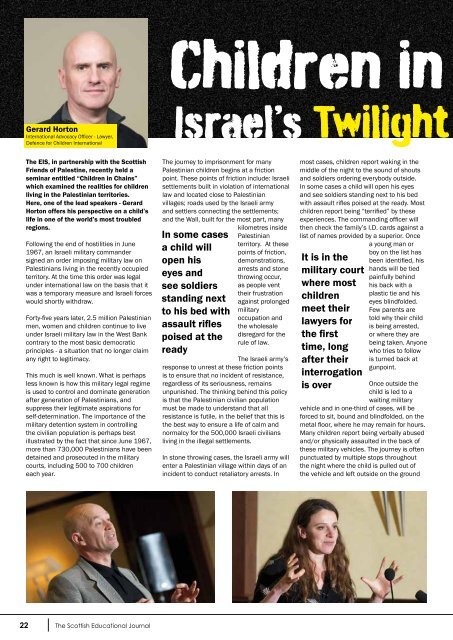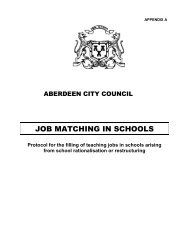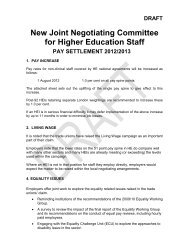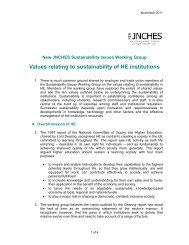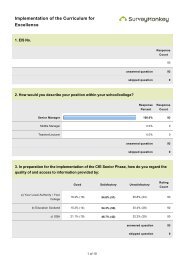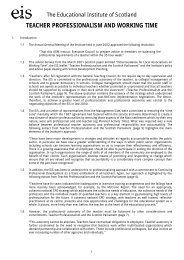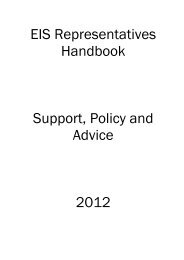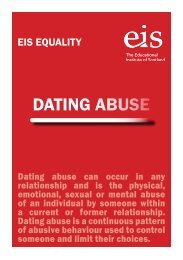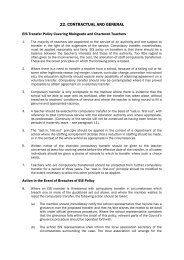The Scottish Educational Journal - EIS
The Scottish Educational Journal - EIS
The Scottish Educational Journal - EIS
Create successful ePaper yourself
Turn your PDF publications into a flip-book with our unique Google optimized e-Paper software.
Children in<br />
Gerard Horton<br />
International Advocacy Officer - Lawyer,<br />
Defence for Children International<br />
Israel’s Twilight<br />
<strong>The</strong> <strong>EIS</strong>, in partnership with the <strong>Scottish</strong><br />
Friends of Palestine, recently held a<br />
seminar entitled “Children in Chains”<br />
which examined the realities for children<br />
living in the Palestinian territories.<br />
Here, one of the lead speakers - Gerard<br />
Horton offers his perspective on a child’s<br />
life in one of the world’s most troubled<br />
regions.<br />
Following the end of hostilities in June<br />
1967, an Israeli military commander<br />
signed an order imposing military law on<br />
Palestinians living in the recently occupied<br />
territory. At the time this order was legal<br />
under international law on the basis that it<br />
was a temporary measure and Israeli forces<br />
would shortly withdraw.<br />
Forty-five years later, 2.5 million Palestinian<br />
men, women and children continue to live<br />
under Israeli military law in the West Bank<br />
contrary to the most basic democratic<br />
principles - a situation that no longer claim<br />
any right to legitimacy.<br />
This much is well known. What is perhaps<br />
less known is how this military legal regime<br />
is used to control and dominate generation<br />
after generation of Palestinians, and<br />
suppress their legitimate aspirations for<br />
self-determination. <strong>The</strong> importance of the<br />
military detention system in controlling<br />
the civilian population is perhaps best<br />
illustrated by the fact that since June 1967,<br />
more than 730,000 Palestinians have been<br />
detained and prosecuted in the military<br />
courts, including 500 to 700 children<br />
each year.<br />
<strong>The</strong> journey to imprisonment for many<br />
Palestinian children begins at a friction<br />
point. <strong>The</strong>se points of friction include: Israeli<br />
settlements built in violation of international<br />
law and located close to Palestinian<br />
villages; roads used by the Israeli army<br />
and settlers connecting the settlements;<br />
and the Wall, built for the most part, many<br />
In some cases<br />
a child will<br />
open his<br />
eyes and<br />
see soldiers<br />
standing next<br />
to his bed with<br />
assault rifles<br />
poised at the<br />
ready<br />
kilometres inside<br />
Palestinian<br />
territory. At these<br />
points of friction,<br />
demonstrations,<br />
arrests and stone<br />
throwing occur,<br />
as people vent<br />
their frustration<br />
against prolonged<br />
military<br />
occupation and<br />
the wholesale<br />
disregard for the<br />
rule of law.<br />
<strong>The</strong> Israeli army’s<br />
response to unrest at these friction points<br />
is to ensure that no incident of resistance,<br />
regardless of its seriousness, remains<br />
unpunished. <strong>The</strong> thinking behind this policy<br />
is that the Palestinian civilian population<br />
must be made to understand that all<br />
resistance is futile, in the belief that this is<br />
the best way to ensure a life of calm and<br />
normalcy for the 500,000 Israeli civilians<br />
living in the illegal settlements.<br />
In stone throwing cases, the Israeli army will<br />
enter a Palestinian village within days of an<br />
incident to conduct retaliatory arrests. In<br />
most cases, children report waking in the<br />
middle of the night to the sound of shouts<br />
and soldiers ordering everybody outside.<br />
In some cases a child will open his eyes<br />
and see soldiers standing next to his bed<br />
with assault rifles poised at the ready. Most<br />
children report being “terrified” by these<br />
experiences. <strong>The</strong> commanding officer will<br />
then check the family’s I.D. cards against a<br />
list of names provided by a superior. Once<br />
a young man or<br />
It is in the<br />
military court<br />
where most<br />
children<br />
meet their<br />
lawyers for<br />
the first<br />
time, long<br />
after their<br />
interrogation<br />
is over<br />
boy on the list has<br />
been identified, his<br />
hands will be tied<br />
painfully behind<br />
his back with a<br />
plastic tie and his<br />
eyes blindfolded.<br />
Few parents are<br />
told why their child<br />
is being arrested,<br />
or where they are<br />
being taken. Anyone<br />
who tries to follow<br />
is turned back at<br />
gunpoint.<br />
Once outside the<br />
child is led to a<br />
waiting military<br />
vehicle and in one-third of cases, will be<br />
forced to sit, bound and blindfolded, on the<br />
metal floor, where he may remain for hours.<br />
Many children report being verbally abused<br />
and/or physically assaulted in the back of<br />
these military vehicles. <strong>The</strong> journey is often<br />
punctuated by multiple stops throughout<br />
the night where the child is pulled out of<br />
the vehicle and left outside on the ground<br />
22 <strong>The</strong> <strong>Scottish</strong> <strong>Educational</strong> <strong>Journal</strong>


